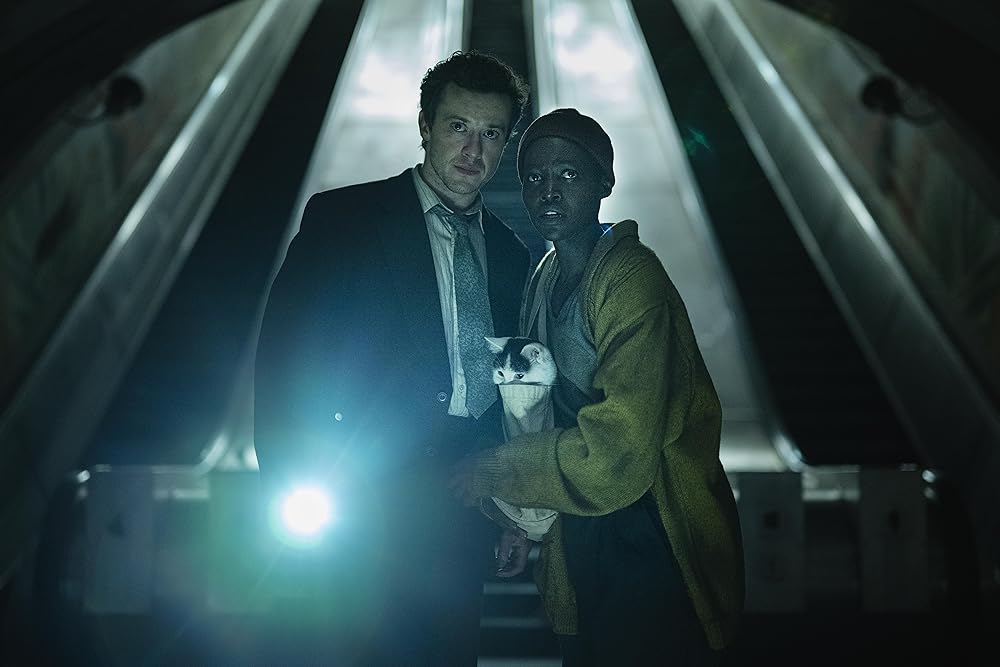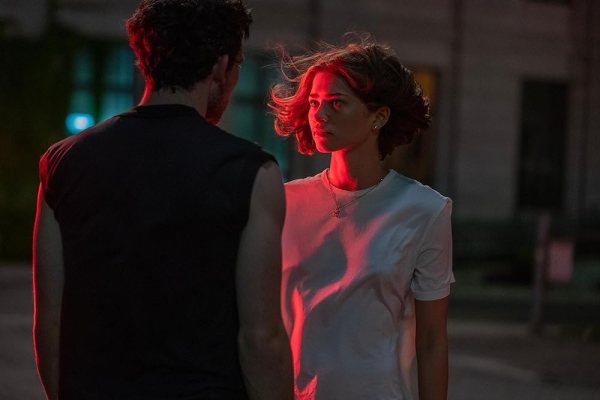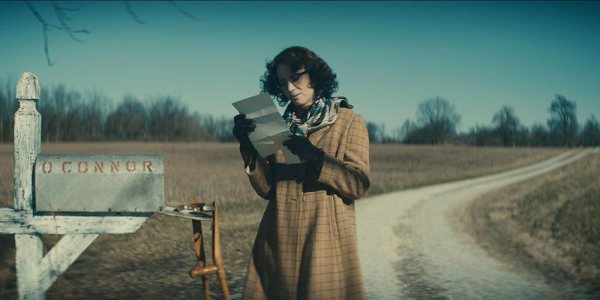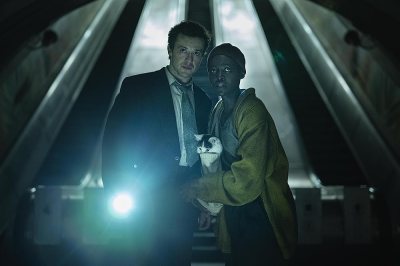There’s no clearer sign of a decaying horror franchise than a gimmicky change of location. Although A Quiet Place (2018) was marred by an often facile screenplay, its rustic, simple setting of an isolated farm helped conjure up a distinctly haunting atmosphere. But after a sequel that largely retained this austere aesthetic to uninspiring effect, the series seems unsure of how to expand on a premise that’s already nearing exhaustion.
A Quiet Place: Day One hopes that the solution can be found in scale and spectacle. This frantic prequel transposes the franchise’s thrills from the verdant valleys of upstate New York to the urban chaos of Manhattan. Unfortunately, the shift in setting makes for a grim evocation of such past ill-conceived horror excursions as Jason Vorhees’ visit to the Big Apple and Lubdan the leprechaun’s Las Vegas vacation. Day One is a derivative and perfunctory exercise in genre conventions, burdened by contrivances and mostly unadorned with memorable scares. At least Lubdan was courteous enough to embrace his own ridiculousness.
We follow Sam (Lupita Nyong’o), a terminally ill cancer patient residing in a hospice center on the outskirts of New York City. She’s lonely and restless but finds a reason to be somewhat cheerful when her nurse, Reuben (Alex Wolff), offers to take her into the city to watch a marionette show. For Sam, the outing is merely a mechanism to achieve her real goal—grabbing one final New York slice at Harlem’s famed Patsy’s Pizzeria.
The show is in Chinatown. But what should be a breezy commute to the restaurant is disrupted when meteorites suddenly strike the city, unleashing an invasion of monstrous, insectoid aliens that begin rampaging throughout the five boroughs, slaughtering everyone in sight. Sam is knocked unconscious during the attack. When she wakes up, her fellow survivors have deduced that the aliens are blind but hypersensitive to sound; even a delicate whisper or crunch of glass will mean certain death for the unfortunate culprit. The government urges all survivors to head for the water since the aliens can’t swim, but Sam, undeterred, instead embarks on an arduous trek to the pizzeria to end her life on her own terms.
Focusing the film on a dying protagonist proves to be an adroit choice on the part of writer-director Michael Sarnoski. Sam has nothing to lose, and it’s easy to relate to her mission of self-liberation. Horror movies are often bedeviled by dimwitted characters who make exclusively foolish decisions, but here, our central player has a compelling reason to do precisely the opposite of what common sense would dictate. Sam’s goal of traversing the island rather than abandoning it allows us to experience all manner of carnage that would be invisible to a character guided by logic.
But since Sam is primarily a vessel through which we can witness the apocalypse, it’s difficult to care about her on a deeper level. As her journey progresses, she encounters Eric (Joseph Quinn), an English law student who’s in shock from the disaster and has no family nearby for an emotional anchor. Despite Sam’s initial reluctance, they quickly develop a friendship that consumes much of Day One’s second half.
It’s unconvincing, however. We learn little about their personalities—Sam is apathetic and taciturn, Eric is peculiar but seemingly good-natured—and though Quinn and Nyong’o are talented actors, Sarnoski’s script gives them little to do besides look at one another with alarm or befuddlement. Horror is the real heart of the film, and their relationship is ultimately a tedious distraction.
At its most effective, Day One offers an oppressive, almost mournful atmosphere. Much of Sarnoski’s imagery is eerily redolent of 9/11, in a manner that recalls Steven Spielberg’s overlooked 2005 remake of War of the Worlds. New York’s streets become covered in ash; its landmarks collapse; and its citizens, huddled together in silently terrified masses, take refuge wherever they can find space. The photography is grubby and gray, devoid of almost a single vivid color, and minor sounds from the tapping of rain to the crunching of gravel shriek disarmingly across the soundtrack.
When these elements provide the foundation for an inventive set piece, watching the film can feel like riding a roller coaster with the breaks removed. One particularly disturbing sequence concerns a group of hopeful escapees who are walking toward the evacuation point. As others gradually join them, the growing group realizes that the combined noise of their breathing and footsteps has become loud enough to attract the monsters—with catastrophic results.
The creativity Sarnoski displays here, however, is frustratingly absent from most of the film. Too many scenes unfold like a visit to a cheap haunted house, as the camera pans delicately around an empty set before an alien suddenly materializes to deliver a predictable jump scare. It’s difficult to feel an immutable sense of tension in part because the creatures simply appear too detached from reality to truly be terrifying. Their design seems better suited to cannon fodder in a sci-fi video game than an inexorable race of horror antagonists.
What’s most baffling about Day One is its refusal to explore the potential possibilities of the Quiet Place premise. When Sam is knocked unconscious as the invasion begins, she passes out for mere hours at most before returning to reality. In that time, the entire human race apparently manages to discern every rule of the creatures’ attraction to sound, as though the initial hours of such anarchy in an area as densely populated as New York City would leave any room for silence. It seemed obvious that Sarnoski would explore how mankind came to learn about the aliens’ behavior and identify their weakness, but all of this is relegated to the imagination.
A Quiet Place: Day One is unable to realize even a modicum of its immense potential. Sarnoski deploys some intriguing ideas, but these are outweighed by hackneyed scares and limp thrills. The film’s climax, which resembles a hastily assembled Frankenstein of action movie clichés, is an especially grievous example of its striking lack of ingenuity. A few glimmers of promise and originality can be found here, suggesting that someday, a director with a robust vision could produce a compelling reinvention of the Quiet Place formula. But until then, it would be best if this series stayed silent.






Please note that we at The Dispatch hold ourselves, our work, and our commenters to a higher standard than other places on the internet. We welcome comments that foster genuine debate or discussion—including comments critical of us or our work—but responses that include ad hominem attacks on fellow Dispatch members or are intended to stoke fear and anger may be moderated.
With your membership, you only have the ability to comment on The Morning Dispatch articles. Consider upgrading to join the conversation everywhere.